Biggest Solar X-Ray Flare on Record - X20
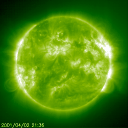 |
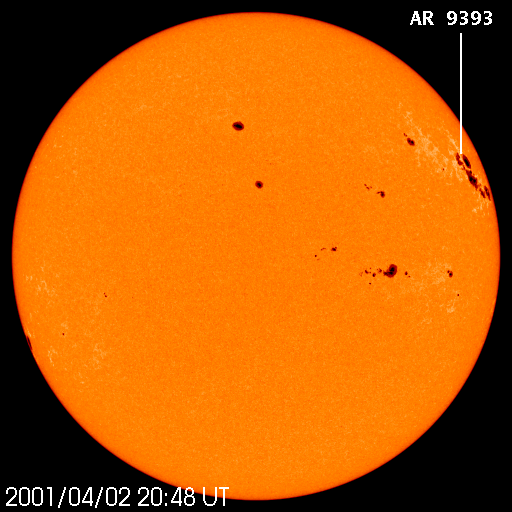 |
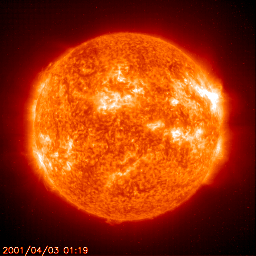 |
Print media: TIFF |
Also: 1024x1024 |
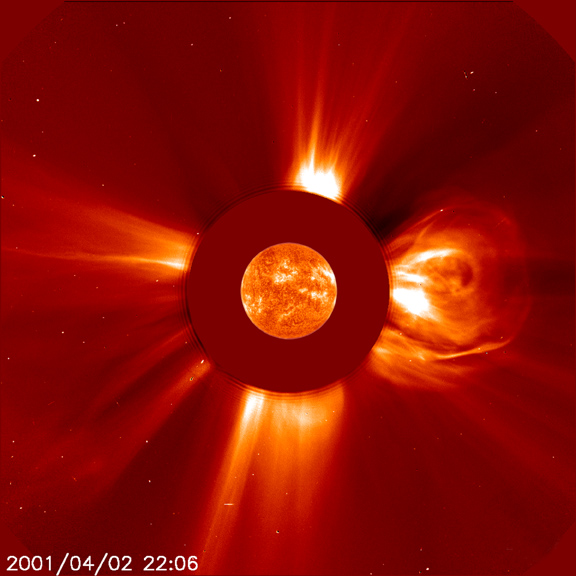 |
 |
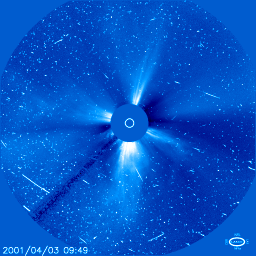 |
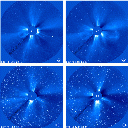 |
Print media: TIFF |
Print media: TIFF |
|
Movies: |
Sound!
|
For mpeg players with fixed frame rate:
Slowed-down mpegs
See also:Real time images/movies
At 21:51 UT, Monday 2 April 2001, active region 9393 unleashed a major solar flare. Now reclassified as at least an X20, it appears to be the biggest X-ray flare on record, most likely bigger than the one on 16 August 1989, also an X20 flare, and definitely more powerful that the famous 6 March 1989 flare which was related to the disruption of the power grids in Canada. The big explosion, which took place near the Sun's northwest limb, hurled a coronal mass ejection (CME) into space - at a whopping speed of roughly 7.2 million km/h - but not directly towards Earth. The shock arrived at SOHO at 14:20 UT, as detected by the SOHO/CELIAS Proton Monitor, shown below:
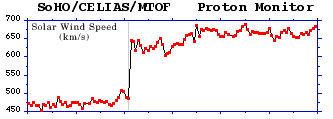
Later the same week, an X5 flare occured in a new region (AR9415) which has rotated onto the disk as the old region disappeared behind the limb. The event was featured in another Hot Shot.
A proton event started only hours after the flare. These highly energetic particles may affect electronic equipment in space. This can be seen in e.g. movies from LASCO and EIT (links above). The apparent "snowstorms" are caused by energetic particles crashing into the detectors. The particle effects of this giant flare on EIT is, however, an order of magnitude smaller than those seen during the so-called Bastille Day event of 14 July 2000.
The active region where the flare occurred, AR9393, is the host of the gigantic sunspot group that drifted across the Solar disk last week. This was the largest sunspot group to occur in 10 years - with a total area 13 times the surface of the Earth at the largest. The active region produced several solar flares and coronal mass ejections during the last week. One of the coronal mass ejections produced a powerful geomagnetic storm that raged for more than 24 hours this weekend, dazzling sky watchers who saw aurora borealis as far south as Mexico.
Given that a comparatively modest flare resulted in such intense geomagnetic activity, we are perhaps lucky that this event didn't occur over the weekend, when the resulting CME would almost certainly have been aimed towards Earth. The CME associated with the X15 flare in March 1989 caused major power failures in Canada, and subsequent smaller events have disrupted communication and navigation satellites. Also, had the flare occured over the weekend we could have seen a major proton storm such as the one observed last July, when a number of SOHO's imaging instruments were temporarily blinded.
More information about major flares can be found here: http://www.ips.gov.au/papers/richard/topflares.html
Press contacts:
Dr. Paal Brekke, pbrekke@esa.nascom.nasa.gov; Tel: 301-286-6903
Dr. Bernhard Fleck, bfleck@esa.nascom.nasa.gov ; Tel: 301-286-4098
Dr. Joe Gurman, gurman@eitv.nascom.nasa.gov ; Tel : 301-286-4767
Links:
- ESA Science release
- NASA press release
- Our Current Space Weather summary.
- Today's Space Weather from SEC/NOAA.
- SpaceWeather.com
- NASA press release
Instruments: Extreme ultraviolet
Imaging Telescope (EIT); Large Angle Spectrometric Coronagraph (LASCO);
Taken: April 2, 2001.
Picture credit: SOHO/MDI, SOHO/EIT, and SOHO/LASCO (ESA & NASA)
Special credit: G. Lawrence (LASCO/NRL) for initial data collection and movies.


